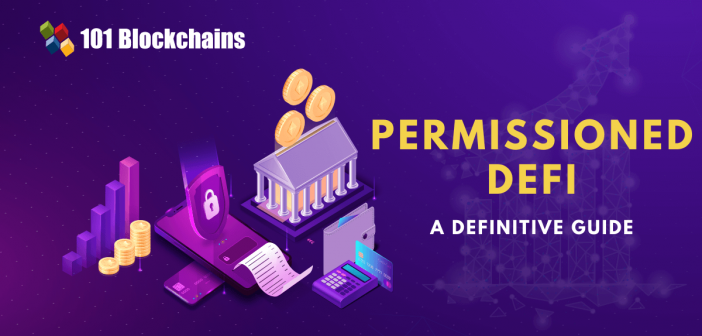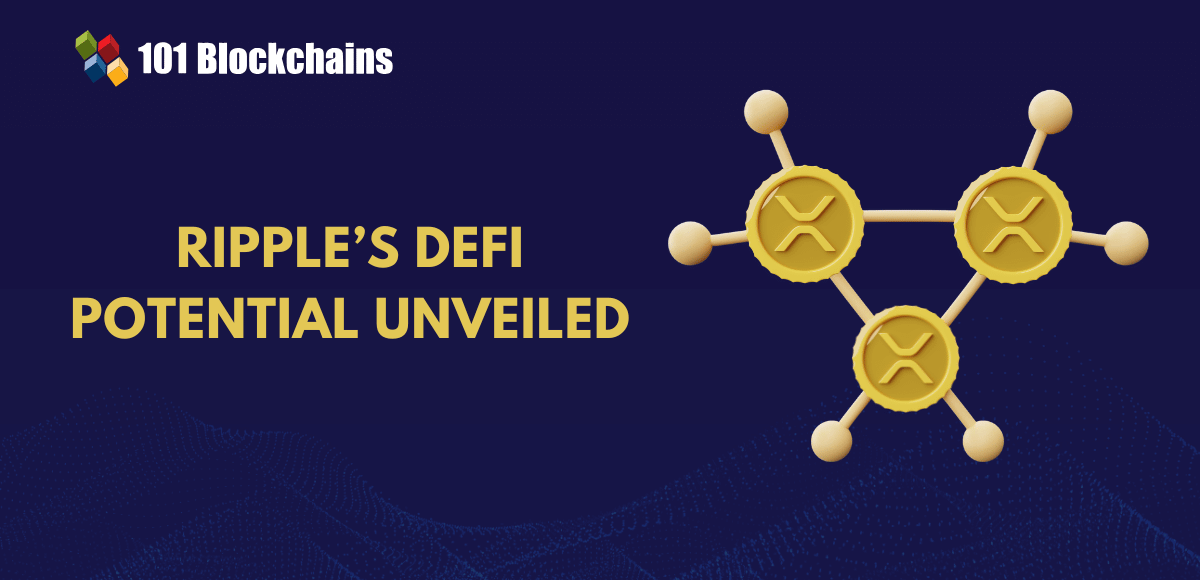Learn how blockchain truly works, master key definitions, and uncover what makes smart contracts so "smart." Dive into the fundamentals, gain valuable insights, and start your blockchain journey today!

- Decentralized Finance
Diego Geroni
- on July 26, 2021
Know Everything about Permissioned DeFi
Do you want to know about the permissioned DeFi? Here we have covered the permissioned decentralized finance in detail!
Decentralized finance has come up as a prolific factor for driving the return of cryptocurrency alternatives back to popularity. It has been touted as the future of finance for all the right reasons. DeFi offers an open and global financial system tailored specifically for the digital age. Decentralized finance aims to provide an efficient alternative to the traditional, tightly controlled, and opaque financial systems prevailing worldwide.
It can enable better control and visibility over your finances alongside empowering you with insights required for better financial decisions. So, where does the topic of permissioned DeFi come in? Is it different from the decentralized finance or DeFi we know today? The following discussion gives you an introductory overview of permission-based DeFi.
Want to learn and understand the scope and purpose of DeFi? Enroll Now in Introduction to DeFi- Decentralized Finance Course
Understanding the Foundations
In order to understand permissioned decentralized finance, you don’t have to spend further energy than the basics of DeFi. A proper outline of the definition of decentralized finance alongside its work could help in understanding how ‘permissioned’ works in DeFi. Decentralized Finance basically points out a collective term allotted to financial products and services through blockchain. Most of the DeFi protocols or solutions in the market today are based on Ethereum.
DeFi ensures that markets are always open, and you could access financial services without the intervention of centralized authorities. As a result, the services in the financial sector, which were considerably slow and had higher risks of human error, could be automated. Now, it is possible to manage financial services through code available for anyone to inspect and evaluate. So, you can clearly notice how DeFi introduces improved transparency, security, and credibility of financial transactions.
Want to explore in-depth about DeFi protocol and its use cases? Enroll In Decentralized Finance (Defi) Course- Intermediate Level Now!
How DeFi Changed Everything?
If you want to learn about permissioned DeFi, then it is essential to find out the differences between DeFi and traditional finance. The differences can help you understand how DeFi overcomes the setbacks in traditional finance evident currently. At the same time, you can also get a fundamental impression of the reasons to introduce permission-based DeFi. Decentralized Finance was tailored for addressing some of the dominant problems in the financial services sector today. Here are some of the notable problems you could find in the financial services sector today.
- People could not access financial services such as setting up a bank account or borrowing money.
- People could not access employment opportunities due to the lack of access to financial services.
- Using financial services also puts personal data at risk.
- Government and centralized financial and regulatory institutions have the power of shutting down markets according to their will.
- Settlement of transactions can take multiple days due to the need for many internal human processes.
- Financial services are associated with premium fees because the financial intermediaries need their commission for facilitating financial services.
- Trading hours are generally restricted to business hours in specific time zones.
The road to permissioned decentralized finance started when DeFi imposed prolific influence on addressing all these setbacks. DeFi enabled people to hold ownership and control over their own money rather than vesting it in the authority of companies. Now, DeFi helps people in controlling the movement and expenditure of their financial assets. Most important of all, DeFi enabled the faster settlement of transactions, generally in a matter of few minutes. Furthermore, DeFi also ensures that markets are always open.
However, DeFi also presents some advantages which have underlying pitfalls. For example, DeFi is openly accessible for anyone. Therefore, malicious agents could also participate in DeFi ecosystems with the intention of compromising the system’s integrity. In addition, the transaction activity is pseudonymous, thereby creating difficulties in ascertaining the identity of parties responsible for certain discrepancies in the system. Such type of setbacks in the DeFi ecosystem gave birth to permissioned DeFi. In order to understand how permissioned DeFi came into existence, it is important to find out how DeFi works.
Want to explore an in-depth understanding of security threats in DeFi projects? Enroll In DeFi Security Fundamentals Course Now!
Working of DeFi
Decentralized finance or DeFi does not depend on any bank for facilitating transactions and other financial services among parties. On the contrary, it leverages the power of technology. DeFi focuses on development of various open-source protocols alongside public blockchain platforms which offer a framework for operations of decentralized finance. So, you would find two critical components responsible for the working of a finance system. The two components include the infrastructure on which the finance system must operate and the currency with which the system would work.
In the case of a centralized system, you would find banks and financial intermediaries working as the infrastructure. On the other hand, fiat currency such as US Dollar or Euro works as currency. DeFi replaces these two components for enabling access to a wide assortment of financial services. You could find both these components in a permissioned DeFi example, albeit with slight differences. Let us reflect on the two components in the working of DeFi to set the ideal foundation to understand permission-based DeFi.
Want to understand the best ways to use DeFi development tools like Solidity, React, and Hardhat? Enroll now in DeFi Development Course!
Understand the Decentralized Finance in this detailed video presentation-
-
Infrastructure
The infrastructure in the case of a blockchain system largely points out to a blockchain platform. Most of the DeFi applications you find today operate on Ethereum for writing decentralized applications. It helps in creating smart contracts which cite the automated code, which can help in the management of financial services. Smart contracts help in setting a specific set of rules for dictating the way in which financial services would work.
Subsequently, the rules have to be deployed to Ethereum. It is important to note that smart contracts cannot be modified after deployment. You could develop decentralized apps on Ethereum for offering any financial services. Smart contracts could help you with the autonomous management of financial services offered through the application.
-
Currency
The next important requirement in DeFi points out the currency. A stable currency is important for the creation of a reliable and highly secure decentralized finance system. In this case, stablecoins are ideal picks to avoid concerns of volatility and incompatibility of other virtual currency alternatives. One of the notable examples of stablecoin used in DeFi applications is DAI. It is a decentralized stablecoin with a similar value as the US Dollar. With the direct backing of US Dollar reserves, DAI is a trustworthy currency for DeFi.
Want to learn the basic and advanced concepts of Stablecoin? Enroll in our Stablecoin Fundamentals Course Now!
Where Does the Problem Arise?
As you can see, decentralized finance can open up a lot of opportunities in the financial sector. However, open accessibility for anyone and anonymity of identity in transactions could lead to profound security concerns. Therefore, permissioned DeFi had to make an appearance for dealing with some of the notable setbacks in DeFi.
What could be possibly wrong with open access to financial services for everyone? This could not be a favorable option for financial transactions in the internal ecosystem of an organization. Permissioned blockchains could offer additional security for DeFi, which is generally one of the top priorities of institutional players in the DeFi ecosystem.
So, what does the ‘permissioned’ aspect change in DeFi? We can get a detailed answer to this question by reflecting on permissioned blockchains. As we know, the blockchain platform is an important component for working with DeFi. It enables the development of applications through which users could access DeFi services.
Permissioned blockchain would ensure the addition of an access control layer. The access control layer would only allow specifically identifiable participants for carrying out particular actions. As a result, you can witness profound differences between permissioned blockchains and public or private blockchains.
Want to know the real difference between Decentralized and Centralized Finance? Check out our detailed comparison guide on Decentralized Vs. Centralized now!
How Does Permissioned Blockchain Work?
The understanding of permissioned decentralized finance basically points out the use of permissioned blockchain as the infrastructure. So, how does it work? It is possible to build and access a blockchain through multiple avenues. Permissioned blockchains would require special permissions for reading, accessing and writing information on the platforms. The inherent configuration of the permissioned blockchain helps in controlling the transactions of participants. In addition, permissioned blockchain also helps in defining the roles of each participant in accessing and contributing to the blockchain.
The use of permissioned blockchain in DeFi also ensures the maintenance of the identity of each participant in the DeFi ecosystem. In addition, permissioned blockchains are considerably different from private blockchains. Private blockchain networks could allow only the known nodes to participate in the network. On the other hand, permissioned blockchain could allow any individual to join the network after definition of their role and identity.
Developers engaged in development of a permissioned blockchain could ensure that certain records are available for every individual to read. For example, developers could opt for showing product names and quantities in a particular transaction to everyone. The permissioning and profile maintenance tasks are carried out through the access-control layer. So, it is clearly different from public or un-permissioned blockchain networks without any control layer.
Check out the A-Z Blockchain Terms to understand Blockchain terminology!
Permissioned Decentralized Finance Examples
It is important to think about the reasons for which permissioned DeFi has become the central topic of discussions in present times. Recently, one of the notable DeFi solutions on the market, Aave, has planned to introduce its permissioned variant. Aave is presently the biggest DeFi lending protocol with over $16 billion locked in cryptocurrency assets. The organization is all set to present the first permissioned DeFi example for institutional investors.
The new permissioned alternative of Aave, Aave Pro, would work with segregated liquidity pools of ‘white listed’ users. The permissioned pools of users would have only those users who have successfully qualified all the Know Your Customer (KYC) protocols. Aave Pro aims at resolving the foremost problem of setbacks for the participation of regulated institutions in decentralized finance.
Now, it is inevitable to wonder about the possible factors that can draw institutions towards Aave Pro. First of all, Aave Pro ensures that users could earn almost 2.1% on US Dollars, reaching up to 3.2% by taking Aave token rewards into account. Interestingly, there is no risk involved in this permissioned decentralized finance application.
The high returns are possible as crypto asset investors do not want to sell their assets. The use of smart contract-based protocol helps users in borrowing up to 85% of the value of their assets. Subsequently, they have to pay only 3.1% for the loan. Aave disclosed that it had been working on permissioned liquidity pools for quite some time now.
Want to learn about Blockchains and Trade Finance? Enroll in our Enterprise Blockchains and Trade Finance Course Now!
Security Identity in Permissioned DeFi
The most notable requirement in DeFi protocols based on permissioned blockchain is the security of identity. People with properly defined roles and identities could access a permissioned DeFi solution. So, what do you find in the practical example of permissioned blockchain DeFi of Aave Pro? Aave has collaborated with digital custody and security agency Fireblocks for addressing the KYC verification procedures.
At present, Aave Pro would continue with one KYC fulfillment service provider in agreement with senior management of different participants. However, the scope for growth of permissioned decentralized finance presents numerous possibilities for the involvement of other custody providers in the future.
At present, the concerns of regulating the DeFi landscape create various confusing choices for organizations participating in DeFi. Regulators may not take any interest in DeFi and follow the use of segregated pools or other organizations for the analysis of blockchain. However, the gradually increasing popularity of DeFi will ultimately bring the question of KYC into the equation.
Furthermore, people are also worried about big institutions pressing their resistance against the introduction of a permissioned variant of DeFi. On the contrary, the arrival of big institutional names in the DeFi ecosystem would slowly encourage other institutional investors to join in.
Become a member now to check On-demand Webinar on DeFi And The Future Of Finance!
Final Words
While one of the prominent benefits of DeFi focuses on its permissionless nature, the arrival of permissioned DeFi creates questions. DeFi opens the financial system to everyone, albeit with certain profound risks. Hackers are able to launder funds by leveraging DeFi protocols as there is no central authority for freezing their finds. The use of oracles in DeFi protocols helps in accessing external data while creating a central point of failure.
Subsequently, security issues in smart contracts are also responsible for putting DeFi users at risk of losing money and data. The use of a permissioned approach in DeFi helps in resolving all these concerns with an additional security layer. Learn more about DeFi and how the permissioned blockchain can revise the infrastructure component of DeFi productively.
*Disclaimer: The article should not be taken as, and is not intended to provide any investment advice. Claims made in this article do not constitute investment advice and should not be taken as such. 101 Blockchains shall not be responsible for any loss sustained by any person who relies on this article. Do your own research!



![30+ Best Decentralized Finance Applications [Updated] best decentralized finance (DeFi) applications](https://101blockchains.com/wp-content/uploads/2020/10/decentralized-finance-applications.png)

